{This post is sponsored by Mountain Rose Herbs}
I wasn’t allowed to drink much soda pop growing up (thanks Mom!), but I did have the occasional root beer when we went out to eat. It was always my favorite with its distinctive flavor that was so different than the regular boring colas. Little did I know back then that the root in root beer meant just that—roots! Traditional root beer is actually made with real roots and herbs. Fast forward a bunch of years, and here I am putting the root back in root beer with this fermented root beer recipe that’s made with a ginger bug!
The Roots and Herbs in Traditional Root Beer
Many different roots and herbs have traditionally been used to make root beer over the years, but the primary one is sassafras root and bark.
In recent years, because of a debatable controversy over the safety of sassafras root due to its safrole content, wintergreen has become the primary flavoring agent.
Beyond sassafras and wintergreen, many other roots, herbs, berries, and spices can be added for more flavor, depending on your preference.
Some common ones are birch bark, sarsaparilla, licorice root, wild cherry bark, ginger, cinnamon, cloves, dandelion root, burdock root, juniper berries, and anise.
Fermented Root Beer Recipe
I decided to stay pretty traditional and use sassafras, sarsaparilla, and birch bark, all from Mountain Rose Herbs (my favorite place to purchase high quality, organic herbs and spices).
Feel free to add in any other herbs, spices, and roots that you’d like.
Related: 12 Fermented Soda Recipes
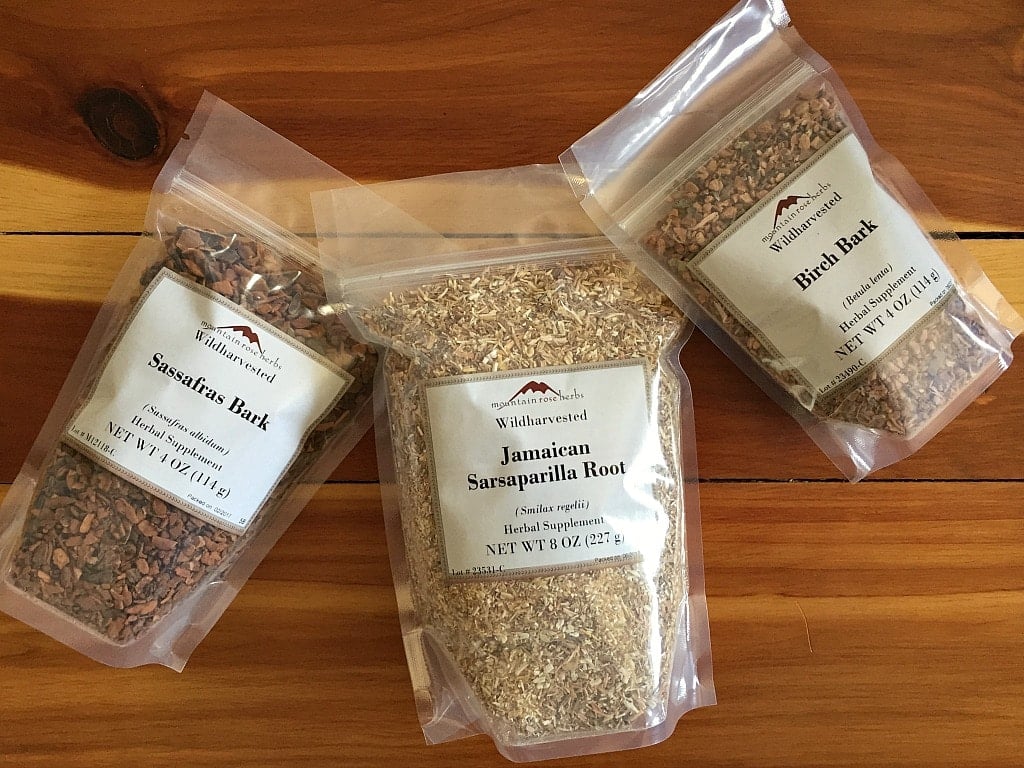
Want to save this post for later?
Make the Ginger Bug
The first step in making this fermented root beer is to make a ginger bug. Since ginger root is also a common ingredient in root beer, this seemed like the perfect choice.
You can follow my recipe for making a ginger bug here.
Boil the Roots & Herbs
Combine the water and herbs in a pot and bring to a boil. Reduce the heat and simmer for 20 minutes. Remove the pot from the heat and let the root and bark tea come to room temperature.
Just smelling these herbs brewing brings back childhood memories of drinking root beer!
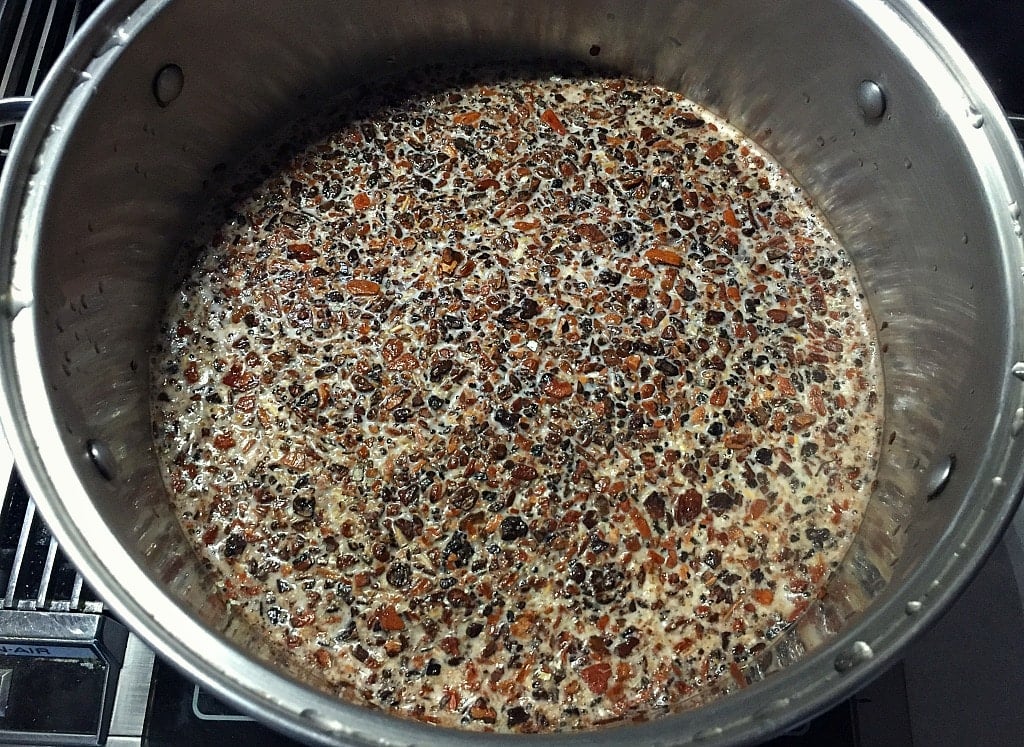
Ferment the Root Beer
Strain out the herbs and put the tea into a wide mouth gallon jar.
Stir in the sugar, molasses, ginger bug, and ginger slices, then cover the jug with a piece of cheesecloth secured with a rubber band.
Put the jar in a quiet corner in your kitchen and let the root beer ferment. Give it a vigorous stir with a wooden spoon once per day. It should start to bubble up within 3-4 days, then it’s ready to bottle.
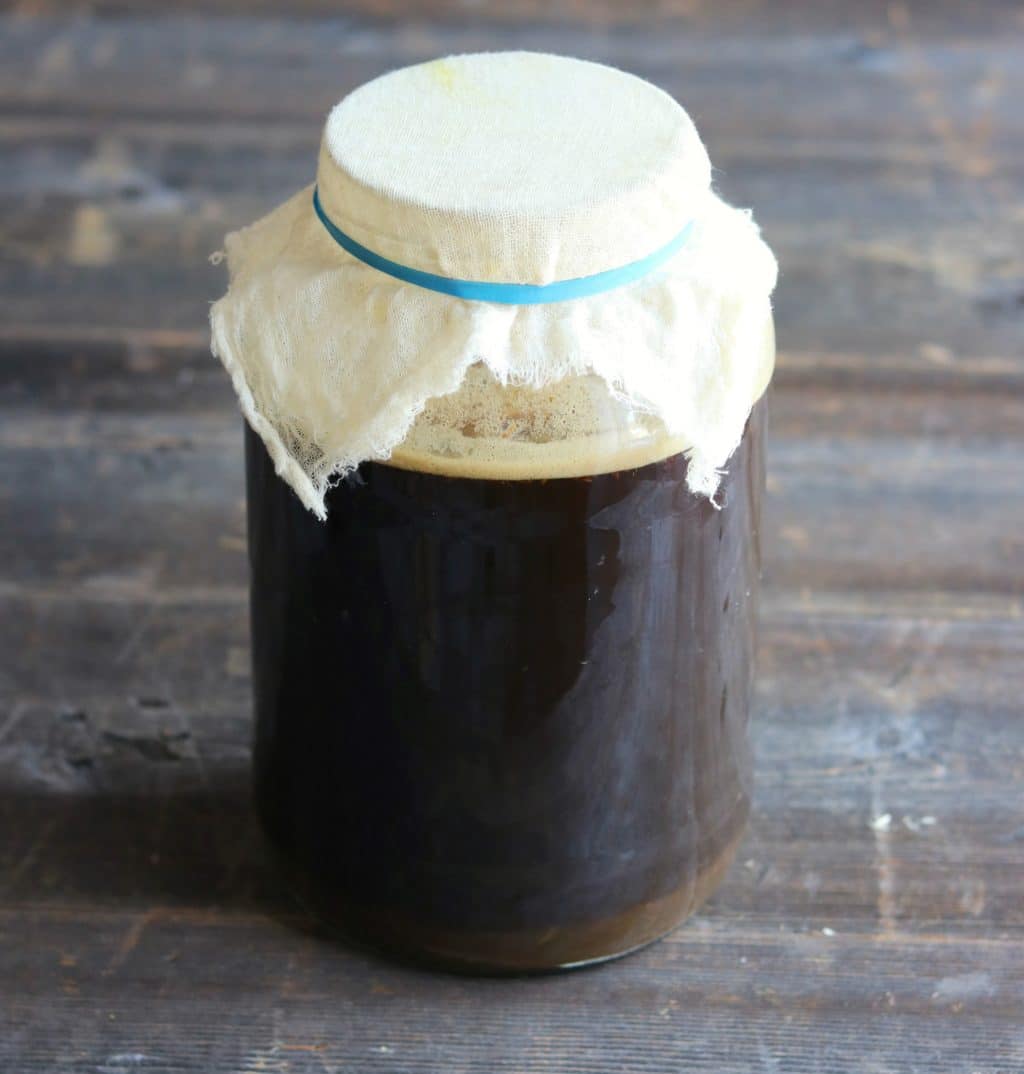
Bottle the Root Beer
Strain out the the ginger pieces and transfer the root beer to flip top bottles using a funnel, making sure to leave an inch or two of head space.
Let the bottles sit at room temperature to build up carbonation for at least a week before drinking your root beer. Serve cold and enjoy!
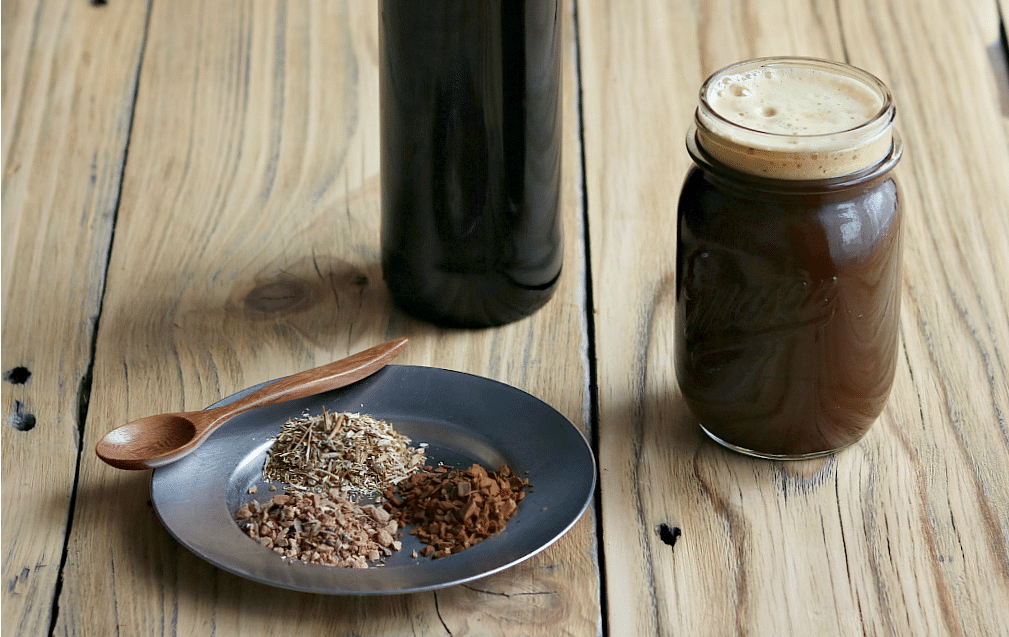
This homemade root beer is so delicious, exactly what real root beer is meant to taste like. I think it’s my new favorite fermented soda!
It even foams up like it’s supposed to, no artificial foaming agents needed (yes, that’s a thing).
Now go get yourself some roots and bark and make some refreshing fermented root beer!
More Fermented Soda Recipes
If you’re interested in making more homemade fermented sodas and beers, I have a few recipes for you:
- Apple Ginger Beer
- Elderberry Soda
- Sweet Potato Kvass
- Turmeric Soda
- Strawberry Rhubarb Soda
- Pine Needle Soda
- Homemade Soda with Yarrow
- Winter Herb Kvass
- Strawberry Water Kefir Soda
Fermented Root Beer
Equipment
Ingredients
- 1 gallon water
- 1/2 cup dried sassafras bark
- 1/2 cup dried sarsaparilla root
- 1/2 cup dried birch bark
- 1 cinnamon stick
- 1 cup sugar
- 1/2 cup molasses
- 1/2-1 cup ginger bug
- 3 slices fresh ginger root
Instructions
- Combine the water and herbs in a pot and bring to a boil. Reduce the heat and simmer for 20 minutes. Remove the pot from the heat and let the root and bark tea come to room temperature.
- Strain out the herbs and put the tea into a wide mouth gallon jar.
- Stir in the sugar, molasses, ginger bug, and ginger slices, then cover the jug with a piece of cheesecloth secured with a rubber band.
- Put the jar in a quiet corner in your kitchen and let the root beer ferment. Give it a vigorous stir with a wooden spoon once per day. It should start to bubble up within 3-4 days, then it's ready to bottle.
- Strain out the the ginger pieces and transfer the root beer to flip top bottles using a funnel, making sure to leave an inch or two of head space.
- Let the bottles sit at room temperature to build up carbonation for at least a week before drinking your root beer. Serve cold and enjoy!
Notes
- Many other herbs can be used to make homemade root beer, including wintergreen, licorice root, wild cherry bark, cloves, dandelion root, burdock root, juniper berries, and anise.
- Mountain Rose Herbs is the best place to get organic dried herbs and spices.

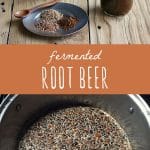
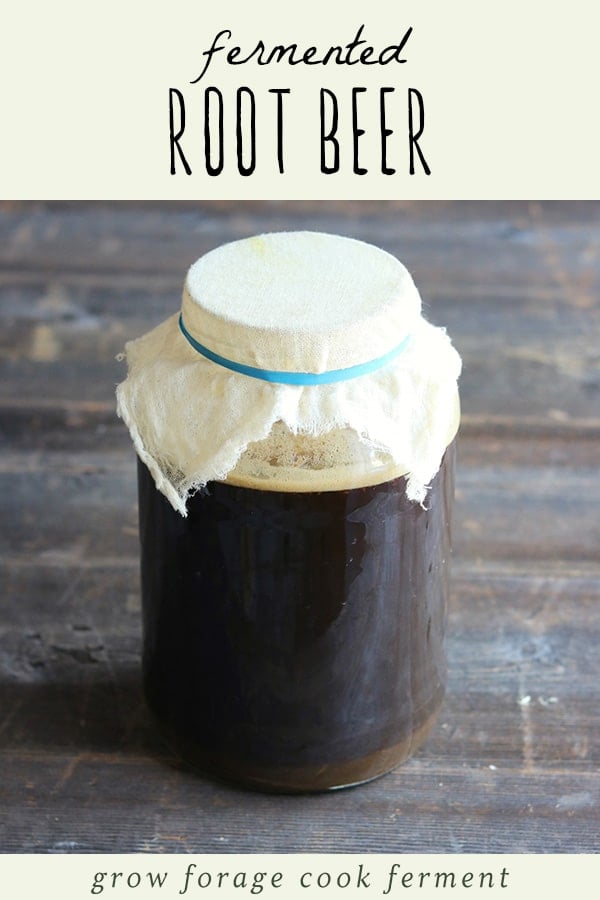
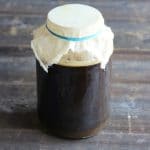

Planning to try this but wanted to double check something: in your ginger bug recipe it calls for a tea or fruit juice. Do I have to add outside tea or is it just adding it to the herb tea for the root beer?
Hi Bowen. I think you may be confusing my ginger bug recipe with someone else’s. Mine only consists of fresh ginger, sugar, and water.
Can I replace with malted barley syrup if I do not have molasses? Will malted barley syrup provide a similar depth in flavor and also provide sugar for the ginger bug?
Barley malt is less sweet than molasses, so you’ll need to add 1 cup of barley malt for every 2/3 cup molasses.
Hi! Is there any concern about feeding this to kids? Obviously it’s a fermented drink. I was thinking I could use this as a half soda syrup, therefore, dilute it with soda water to cut the alcohol content. What are your thoughts?
Can fresh ingredients be used instead of the dried? If so, any idea what different measurements should be used. I’d love to make something like this with burdock, sandelion, and sassafras’s roots…. But would love to try using fresh if possible.
Hi Liz. I haven’t made this recipe with dried so it’s really hard for me to say. Dried ingredients are far more potent than fresh, so I would maybe start with at least a quarter to half of the quantities in my recipe. Let me know how it turns out!
Do you have a book with all of your recipes in it that are on this site?
Hi Michelle. All my books are found here: https://www.growforagecookferment.com/books/
Thanks for the recipe! I just realized I accidentally ordered Sassafras powder…will this be okay to use?
Hi Melissa. That should be fine.
How many ounces or grams are each of the 1/2 cup of herbs? I want to be sure I order enough but not more than I need.
I appreciate your recipes. I find I’m pinning quite a few of them.
Hi Bethany, if you click on where it says “metric” over the ingredient list it will convert it to grams!
I just brewed this today and followed the recipe closely. For those wondering the metric is wildly off.
1/2 cup sassafras bark is 35 grams
1/2 cup birch bark is 35 grams
1/2 cup sarsaparilla root is 40 grams
1 cup of sugar is 185 grams
1/2 cup of molasses is 125 ml
1 cup ginger bug is 250 ml
3 slices of ginger root is 6 grams
And I used an 8 gram cinnamon stick
Cheers!
Hi,I have made this and love the taste but I have problem when I open my bottles, it gushes everywhere! As my poor dogs will testify! I waited 3 days before bottling and putting in the fridge after 2 days on the work top and then I opened one and got covered.Should I have left the mixture longer before bottling?
Hi Bev, that’s the tricky thing about fermenting! So many factors come into play to determine how fast or slow it ferments, including temperature. It sounds like you could have waited another day or two before bottling.
Hi. Thanks for the recipe! Ginger bug was started without problems, but I’m now 5 days in with the root beer recipe and still no bubbling. It produces a bit of froth when I vigorously shake it, but once settled – nothing. What might I be doing wrong? I’m off grid so the house can get pretty cold (down to about 16’C at night), but the ginger bug fermented just fine so I don’t see why it would be that. I used organic ginger and the herbs from Mountain Rose…
Hi Wesley, It’s likely taking longer to ferment due to the inconsistent temperature in your home. Typically you want to maintain a temperature roughly 10 degrees warmer. I would move it to a warmer location or let it ferment longer.
Ok, thanks for the feedback Colleen! I moved it to the consistently warmest location in the house (on top of my battery bank), and I also added about another 1 Tbsp of sugar to hopefully kickstart the fermentation process. Fingers crossed!
Good luck!
I’ve made the root beer and we bottled tonight. Can you add a little more sugar when you bottling? There’s no sweetness at all it seems.
Hi Amanda, you could do that, but you’d need to be extra careful as adding more sugar at bottling can increase the chance of bottle explosions.
Hi! Is there any concern about feeding this to kids? Obviously it’s a fermented drink. I was thinking I could use this as a half soda syrup, therefore, dilute it with soda water to cut the alcohol content. What are your thoughts?
Greetings! I just received all the ingredients and am ready to make this recipe! Too excited! I do have a question for you, I am in agreement with some of the others who have commented previously that the molasses does have a bit of a strong flavor and can overtake the recipe. If I chose to omit the molasses and use Sucanat (Sugar Cane Natural by Wholesome) in place of the sugar since it has all it’s natural properties it does taste a bit like molasses. Would you then add anything else in place of the molasses?
I haven’t used anything except molasses, so I can’t vouch for the flavor of your finished product. You could always do half molasses and half Sucanat or any ratio that suits your taste.
I think I must have done something wrong my root beer is extremely bitter do you have any advice for me?
I’m so sorry! It’s hard for me to know exactly what, if anything, went wrong.
Cook teas from a small amount of your individual herbs and taste. It’s unlikely that fermentation produces bitter taste; it probably comes from one of the ingredients. Then omit or reduce that component.
Hi there, is it possible you used black strap molasses? very dark and bitter. I have been reading a lot of old fashioned recipes and “molasses” often comes up and I never knew there are different types! Here in the UK if you buy molasses, it will always be black strap which is last stage of sugar refining and is essentially the tar left over and not pleasant.
Perhaps you can get light molasses online or maybe substitute for demerara sugar or a either white sugar or a mix of light and brown?
I used blackstrap molasses for this recipe, but you can use any combination of sugars as a substitute if you’d like!
Trying out this recipe right now! I’m just wondering, why are the herbs removed before fermenting?
Boiling the herbs (making tea) depletes them of all their flavor so it’s redundant to have them in your mason jar as it ferments. It also makes it easier to strain out only the ginger pieces during the bottling process.
I’ve tried twice now on the Ginger bug, following instructions to the T and both times the bug never came to fruition (bubbling,working?)
Did you use organic ginger?
This. Conventional ginger is often irradiated. Gives long shelf life by killing off all the germs. The latter are what you want to get to work in your bug.
Should you strain the ginger bug and just use the liquid, or include the grated ginger?
Yes, you’ll want to strain the ginger bug and use the liquid in any fermented soda recipe.
I just picked up all of the ingredients to make this! I saw some reviews about the molasses being strong…I picked up blackstrap and I’m hoping it’s the right kind. Also, I’m curious if after the first fermentation, a second fermentation with champagne yeast or some other kind could possibly result in a boozy root beer? Thoughts? I don’t know much about making hard beverages but I think that could potentially be good.
I used blackstrap molasses in mine and it came out wonderful. I’ve never done a second fermentation with this recipe, but it could be worth a shot!
Can you use fresh sassafras? Growing up we would pluck it out from the ground and make a tea and I’m wondering if anyone had tried that for the root beer?
By. Bubble up do you mean on its own sitting still or when your stir. It froths up
Do you get a lot of sediment after carbonation? I just finished and there’s about a 1/4 inch of sediment at the bottom of each bottle and some around the neck. Normal? Or did I mess a process up somewhere?
Yes there will be yeast at the bottom from the secondary fermentation for carbonation.
Yes, homebrewer here, that stuff at the bottom of the fermentation vessel is flocculated yeast (yeast cells that have clumped together and fallen out of suspension after they ran out of work to do). It is perfectly normal in fermented liquids. I pour off the top and stop pouring when the liquids start turning cloudy. You can drink the cloudy stuff too if you like the flavor, but I save that last pour for myself because I like cloudy/hazy beers, and I don’t mind the flavor. That way the stuff I serve to others is clear and appetizing for most people.
My brother Paul and dad Einar used to make fermented root beer back in the late 50s. I wish I had paid attention to how they made it. I remember the big gallon jugs fermenting in the basement. And they let me drink it at age 10. Dad was a Presbyterian minister. I wonder if he knew he had his little daughter drinking slightly alcoholic root beer. Anyway, it was strong flavored but delicious. Thanks for the recipe. I might try it for old times’ sake.
I tried this recipe, and it tasted awful, I think solely because of the molasses. It overtook everything else. Is it ok to just use a little molasses for color, and for the rest substitute sugar? Also, I’m wondering if molasses spoils over time. I had some, and I don’t use it often, so it’s certainly not new.
It may have to do with what kind of molasses you used. Blackstrap molasses is very dark and has a VERY strong taste. I don’t like it. Golden molasses is lighter in both color and flavor. I think there might be a middle one as well, but these are the only two I’ve ever used.
I’ve had molasses sit for up to a year without spoiling.
Hi, I was wondering if you could subsitute Honey for the sugar? I try to stay away from refined sugar.
Yes you can, you’ll basically be a root beer mead. Just remember that fructose can be sweeter, so you may want to use a small portion less honey. I recommend using raw honey as it’ll have more complexity of flavor.
Do you have any other sources to buy herbs from? Mountain Rose Herb is out of stock on all the ingredients.
Monterey Bay Spice Co
Ebay is actually a good place to buy bulk herbs in small amounts.
Hello! I am making this root beer recipe. I realized that I got sassafras leaf rather than the bark. Will this be ok? I have already brewed the herbal tea.
Not sure what taste you will get from it. Leaves taste totally different from the bark or root. Leaves are used for making file (fee-lay) for use in gumbo.
Birch bark seems to be out in many places. What amount of birch bark powder would work in this recipe? 1/3 cup seemed too much in the recipe. I would also start out with 3/4 gallon of water because you don’t have much room left in a gallon jar to add the sugar, molasses and the rest. I make a lot of ginger beer and ginger bugs, and that has been my experience. :)
I call for one gallon of water because it is boiled for 20 minutes so will reduce down. I’ve never used birch powder so I’m not sure how much to use, and I would worry that it might make your root beer a bit gritty unless filtered out really well.
Looking to harvest my own birch bark. Do you know if this is inner or outer bark that your recipe calls for? Thank you!
Hi Elle. You’ll want to harvest the inner bark for medicine making.
Ok, so of those who commented before that you planned on trying this recipe, I’m curious to know how it turned out both with taste and in process? I’ve got $75 worth of ingredients sitting in my shopping cart but have yet to pull the trigger on the order b/c I’d like to hear some feedback from folks that have actually experimented. I’ve been looking at this recipe for a few weeks now and keep coming back to this page to drool over the pictures. Updates please!
Thanks,
Jerrod B.
Mine came out super strong tasting! It might be the molasses or one of the root. Can herb potency sometimes vary and be overwhelming? Thinking of brewing sassafras tea and sasparilla tea to check potency and adjust.
Hello,
When you say a few slices of ginger, how large are the slices? This looks like a great recipe and I am looking forward to making it! Thank you for posting it. =)
As large as you slice them (it doesn’t really matter, haha!)
Do you think this recipe would work with coconut sugar? Also, I’m not familiar with the sassafras controversy. Do you think this recipe is safe in moderation for toddlers? So happy I found your site! Making sourdough tortillas now!!!
I’ve never tried it with coconut sugar, but it’s my understanding that it doesn’t work well for fermentation. I would probably not give this to toddlers, not only because of the sassafras, but because there is a small amount of alcohol that forms during the fermentation process.
Is there any alcohol content with the “beer”. I know kombucha has trace amounts, but not sure about this drink.
Hi! I love real root beer and would like to try your recipe. Here, we’re not too fond of sarsparilla. If I want to leave it out of this recipe, do I then replace it with more of the other roots? Thanks!
Hi,
What is ginger bug and where can you get some? Is it the same as Ginger root?
You need to make the ginger bug first, it is made with ginger root. You can get instructions on how to make it here: How to make a ginger bug
Just sayin’. You are the best!!!
I have not started brewing but your recipes are on the top of my list!
Thank you!
Following,
Kathleen